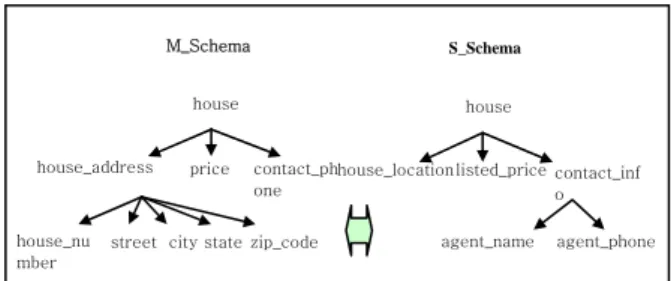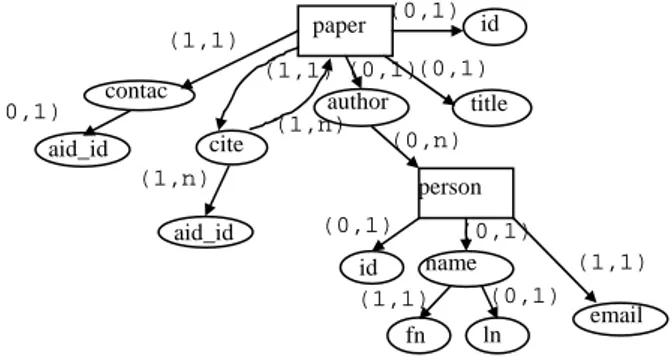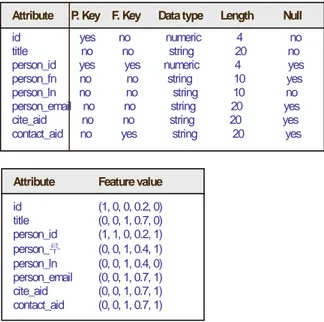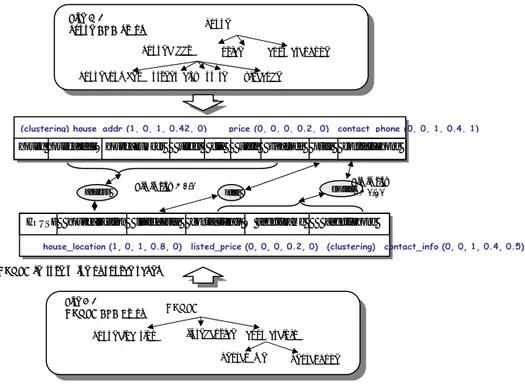ICCAS2005 June 2-5, KINTEX, Gyeonggi-Do, Korea
1. INTRODUCTION
As Extensible Markup Language (XML) is fast emerging as the dominant standard for representing data in the World Wide Web, numerous researches have been spurred to facilitate research on the integration of information on the Web.
To integrate information or to query in an information integration system, the system has to select the relevant information of several diverse Web sites. In Fig.1, each site has different XML schema such as Source schema_1, Source schema_2 and Source schema_n in Realty.com, Homeseekers.com and City.co.kr respectively. Though we can usually find a similar XML schema in a same type of business Web sites, finding most similar source schema corresponding mediated schema manually is very labor intensive and error prune job.
One major bottleneck in information integration on the XML based World Wide Web is an equivalent schema matching between mediated schema and several different source schemas. In this paper, we present the first complex matching of XML schema, i.e. XML DTD. The proposed method captures not only schematic information but also integrity constraints information of DTD to match different structured DTD. We show the integrity constraints based hierarchical schema matching is more semantic than the schema matching only to use schematic information and stored data.
Fig. 1. Schema matching in an information integration system
2. PROBLEMS AND RELATED WORKS
As XML DTD has nested tag structures, matchinghierarchical XML DTD to other XML DTD is not a trivial task (Fig. 2). There are several difficulties including non 1-to-1 mapping, set values and recursion issues. Recently, several matching method for XML DTD to other XML DTD, but most of all match 1-to-1 matching of each leaf node [1, 2, 3].
A XML Schema Matching based on Fuzzy Similarity Measure
Chang Suk Kim* and Kwee-Bo Sim**
* Department of Computer Education, Kongju National University, Chungnam, Korea (Tel : +82-41-850-8822; E-mail: csk@kongju.ac.kr)
**School of Electrical and Electronic Engineering, Chung-Ang University, Seoul, Korea (Tel : +82-2-823-5319; E-mail: kbsim@cau.ac.kr)
Abstract: An equivalent schema matching among several different source schemas is very important for information integration
or mining on the XML based World Wide Web. Finding most similar source schema corresponding mediated schema is a major bottleneck because of the arbitrary nesting property and hierarchical structures of XML DTD schemas. It is complex and both very labor intensive and error prune job. In this paper, we present the first complex matching of XML schema, i.e. XML DTD, inlining two dimensional DTD graph into flat feature values. The proposed method captures not only schematic information but also integrity constraints information of DTD to match different structured DTD. We show the integrity constraints based hierarchical schema matching is more semantic than the schema matching only to use schematic information and stored data.
Keywords: XML, schema matching, fuzzy similarity, DTD, integrity constraints
Fig. 2. Matching problem of mediated schema and source schema
Extracting integrity constraints as well as structural information play an important role in schema matching. Doan [3] proposed an automatic schema mapping using machine learning approach. But he used similarity of attribute name and semantic of stored data. Doan did not consider operator node ?, * or + of XML DTD. Milo [2] performed schema matching based on the name and structure of schema elements. The SEMINT system uses neural network learner to compare both schema. SEMINT consider only relational schema, so it could not be applied in XML schema matching [1]. SEMINT did not consider hierarchical structures of schema.
3. XML DTD MATCHING USING INLINE
ALGORITHM
We tried a new trial to matching hierarchical XML
DTD to other hierarchical XML DTD. But we could not
directly compare them because XML DTD structures
are different case by case though they have similar
meaning (Fig. 2). The basic idea of this paper is to
transform a XML DTD into some kinds of template that
has structural information and integrity constraints
extracted from the DTD. In order to directly DTD
house
house_address price contact_ph one house_nu
mber
street city state zip_code
house
house_locationlisted_price contact_inf o agent_phone agent_name M_Schema S_Schema Source schema_n Source schema_2 <!ELEMENT phone ……>
“Retrieve apartments which are have three bed rooms, two bathrooms, built-in furniture and good grade school zone”
Mediated h
Source
<!ELEMENT owner (#PCDATA)> schema_1
Realty.com Homeseekers. com City.co.kr Matching Similarity = 0.91 0.88 0.83 <DOCTYPE house_type [
<!ELEMENT house (address, owner, phone+)> <!ATTLIST address id ID #REQUIRED>
………….
house(number, location, contact_pointer) ………….
ICCAS2005 June 2-5, KINTEX, Gyeonggi-Do, Korea
matching, hierarchical DTD structure is transformed to
a flat feature array (FFA) structure.
Recently, several transformation algorithms that XML
data into relational data, have been proposed [4, 5, 6].
We chose one particular transform algorithm, called the
hybrid inline algorithm and add constraints properties.
Lee [4] proposed semantic knowledge derivation from
XML DTD for transforming XML data to relational
database. These algorithms will be used to generate a
flat feature array structure that is template to compare
XML DTD.
3.1 Transform Hierarchical DTD Structure into Annotated DTDGraph
In this section, converting a XML DTD into annotated DTD graph is shown. Fig. 3 shows a DTD for publication that states a paper element to have four sub-element: title, contact, author and cite in that order. As common in regular expression, zero or one occurrence is represented by the symbol ?, zero or more occurrences is represented by the symbol *, and one or more occurrence is represented by symbol +. Keywords #PCDATA and CDATA are used as string types for elements and attributes, respectively.
A XML document example of the DTD of Fig, 3 is shown in Fig. 4.
<DOCTYPE publication [
<!ELEMENT paper (title, contact?, author, cite?)> <!ATTLIST paper id ID #REQUIRED> <!ELEMENT title (#PCDATA)>
<!ELEMENT contact EMPTY>
<!ATTLIST contact aid IDREF #REQUIRED> <!ELEMENT author (person+)>
<!ATTLIST author id ID #REQUIRED> <!ELEMENT person (name, email?)> <!ATTLIST person id ID #REQUIRED> <!ELEMENT name EMPTY>
<!ATTLIST name fn CDATA #IMPILED ln CDATA #REQUIRED> <!ELEMENT email (#PCDATA)> <!ELEMENT cite (paper*)>
<!ATTLIST cite pid ID #REQUIRED format (ACM|IEEE) #IMPLIED> ]>
Fig. 3. A DTD for the publication <paper id=TR-2003-006 >
<title>XML Schema Matching</title> <contact>aid= Chulsoo </contact> <author>
<person id=Chulsoo >
<name fn=Chulsoo ln=Park /> <email>clpark@hanmail.net</mail> </person>
<person id= Chulsoo>
<name fn=Soonee ln=Hong /> <email>soon@yahoo.com</mail> </person>
</author> </paper>
Fig. 4. A XML document for the publication
Fig. 5. Annotated DTD for publication in Fig. 3
To make a FFA, hierarchical DTD have to be created an annotated DTD graph that represents the structure of DTD and cardinality relationship type A, B, C or D. Its nodes are element attributes and operators in the DTD. Each element appears exactly once in the graph, while attributes and operators as many times as they appear in the DTD. Attributes with #IMPLIED or IDREFS type are converted to operator node? or + in a DTD graph.
3.2 Extracting Semantic Integrity Constraints from DTD
Some types of semantic constraints hidden in DTD are presented in this section. Several papers have been proposed about it [4, 7]. For clear presentation, we chose Lees notation since it exhibited more clear and explicit. There are five possible constraints in DTD such as cardinality constraints, domain constraints, inclusion dependencies, equality-generating Dependencies (EGDs) and tuple-generating dependencies (TGD) [4]. We use the cardinality constraints and the domain constraints to generate a FFA. There are four possible cardinality relationships between an elements and its sub-element as illustrated below.
<!ELEMENT paper (title, contact?, author+, publisher*)> Let us call each cardinality relationship type A, B, C and D, respectively. We can infer four mapping information from these cardinality relationships.
1. 1-to-{1} mapping (only semantics) : NOT NULL (A Type)
2. 1-to-{0, 1} mapping (at most semantics) : NULLable (B Type)
3. 1-to-{1,…} mapping (at least semantics) : NOT NULL(C Type)
4. 1-to-{0,…} mapping (any semantics) : NULLable(D Type)
Extracting semantic constraints from DTD systematically are described in CPI(Constraints preserving Inline Algorithm) [4]. We show how to represent them in FFA. It can be find semantic constraints from the annotated DTD graph in Fig. 5. We can see not only the relational schema
information, but the semantic constraints such as not null, primary key, foreign key or data type.
The feature value is normalized form of the structural information and constraints for an attribute. For example, if the feature of an attribute is primary key, non-foreign key, numeric data type, four bytes data type length, non-nullable,
title paper contac fn person author id ln name email (1,1) (1,1) cite aid_id aid_id (0,1) (1,1) (1,n) (1,n) (0,1) id (0,1) (0,1) (0,n) (0,1) (0,1) (0,1) (1,1)
1483
ICCAS2005 June 2-5, KINTEX, Gyeonggi-Do, Korea
then its feature value is (1, 0, 0, 0.2, 0). The feature values
element has numeric values from 0 to 1 as [0, 1]. The value range of 0-1 is depends on functions of normalization.
Fig. 6. Flat feature array for Paper
4. FUZZY SIMILARITY MEASURE USING
FEATURE COMPARISON
The flat feature array(FFA) includes all the properties of DTD for matching other DTD. The process of FFA comparison is shown in Figure 7. There are two types of FFA. One is simple type FFA and the other is clustering type FFA. The simple type FFA consists of information for primary key, non-foreign key, numeric data type, four bytes data type length, non-nullable of an attribute. The clustering type FFA is combining the feature values of several clustering attributes. The similarity rate of clustering type FFA can be calculated following formula Sim(M, S) [10]. It represent a similarity or likeness between a attribute and clustered attribute.
We can see the extent of similarity between mediated schema (M_schema) and source schema (S_schema) is high such as 0.92, 0.90 and 1.0. If the value of Sim(M, S) is 1.0, then the both attributes have the same meaning.
In this example, Mediated_Schemas house_addr has five attributes as house_number, street, city, state and zip_code. But, on the other hand, S_Schemas house_location attribute is single. So we cant compare the similarity directly. First of all, clustering feature value of the five attributes should be obtained. Then we can find similary between the clustering attribute house_addr and the single attribute house_location.
The similarity rate between M_Schemas house_addr and S_Schemas house_location is calculated by Kims method as following [8, 9].
∑ | feature value(M) – feature value(S) |
|X|
Here, M and S means M_Schema and S_Schema respectively. |X| is number of feature value’s element. Following expression is a similarity between M_Schema and S_Schema.
Sim (contact_phone, contact_info)
| 0 – 0 | + | 0 – 0 |+ | 1 – 1 | + | 0.4 – 0.4 | + | 1 – 0.5 | | 5 |
SIM (house, HOUSE) ≈ 0.94
(similarity between M_Schema and S_Schema)
5. CONTRIBUTION AND FURTHER WORKS
In this paper, we have presented the first hierarchial matching of XML DTD that provides practical assistance in finding equivalent schema between mediated schema and several different source schemas. XML DTD is usually complex since its structure is hierarchical and nested. Thus, matching these schemas directly is laborious and error prune job. So most of all the previous works were 1-to-1 matching. The proposed method makes a hierarchical DTD structure to be flattened and then it captures not only schematic information but also integrity constraints information of DTD. These information makes effective schema matching processing. The first contribution of this work is the complex schema matching not 1-to-1 matching. Next contribution is to use constraints information for more accurate comparison.There are still rooms for improvement extracting semantic information from DTD and experiments to evaluate the feasibility of our approach. In the near future we would like to explore these issues.
ACKKNOWLWDGEMENTS
This work was supported by grant (04-Basic-018) from the Basic Research Program supported by Ministry of Information and Communication and (R01-2002-000-00068-0) from the Basic Research Program of the Korea Science & Engineering Foundation in Republic of Korea.
REFERNCES
[1] W. Li and C. Clifton, SEMINT: A tool for identifying attribute correspondences in heterogeneous databases using neural networks, Data & Knowlwdge Engineering 33, pp. 49-84, 2000.
[2] T. Milo and S. Zohar, Using Schema Matching to Simplify Heterogeneous Data Translation , Proc. on VLDB, New York, USA, pp. 122-133, 1998.
[3] A. Doan, P. Domingos and A. Levy, Learning Source Descriptions for Data Integration, Proc. on WebDB 2000, pp. 81-86, 2000.
[4] D. Lee and W. Chu, Constraints-preserving Transforma -tion from XML Document Type Definition to Relational Schema, UCLA-CS-TR-200001, 2001.
[5] J. Shanmugasundaram, K. Tufte, G. He, C. Zhang, D. Dewitt and J. Naughton, Relational Databases for Querying XML Documents: Limitations and Opportunities, Proc. on VLDB, Edinburgh, Scotland, pp. 302 314, 1999.
id yes no numeric 4 no title no no string 20 no person_id yes yes numeric 4 yes person_fn no no string 10 yes person_ln no no string 10 no person_email no no string 20 yes cite_aid no no string 20 yes contact_aid no yes string 20 yes
Attribute P. Key F. Key Data type Length Null
= 1 –
= 0.90
Attribute Feature value
id (1, 0, 0, 0.2, 0) title (0, 0, 1, 0.7, 0) person_id (1, 1, 0, 0.2, 1) person_루 (0, 0, 1, 0.4, 1) person_ln (0, 0, 1, 0.4, 0) person_email (0, 0, 1, 0.7, 1) cite_aid (0, 0, 1, 0.7, 1) contact_aid (0, 0, 1, 0.7, 1) Sim(M, S) = 1 –
1484
ICCAS2005 June 2-5, KINTEX, Gyeonggi-Do, Korea
[6] A. Deutsch, M. Fernandez and D. Suciu, Storing
Semistructured Data with STORED, Proc. on SIGMOD, Philadelphia, USA., 1998.
[7] P. Wood, Optimizing Web Queries Using Document Type Definitions, Proc. Intl Workshop on Web Information and Data Management, pp. 1-5, 1999.
[8] C. S. Kim, Systematic Generation Method and Efficient Representation of Proximity Relations for Fuzzy Relational Database Systems, Proc. of the 20th EUROMICRO Conference, Liverpool, England, IEEE Computer Society Press, pp.549-555, 1994.
[9] C. S. Kim, A Complex Matching of XML Schema, Proc. of the 20th International Conferenceon Internet Computing, Las Vegas, Nevada, U. S. A., CSREA Press, pp.484-489, 2002.
Fig. 7. The process of FFA comparison between M_schema and S_Schema
HOUSE house_location listed_price contact_info Æ agent_name agent_phone
house_location (1, 0, 1, 0.8, 0) listed_price (0, 0, 0, 0.2, 0) (clustering) contact_info (0, 0, 1, 0.4, 0.5)
house house_addrÆhouse_number street city state zip_code price contact_phone
(clustering) house_addr (1, 0, 1, 0.42, 0) price (0, 0, 0, 0.2, 0) contact_phone (0, 0, 1, 0.4, 1)
address Similarity = 1.0 price contact = 0.90 Similarity
HOUSE feature value of source schema
HOUSE
house_location listed_price contact_info agent_phone agent_name
Site B :
HOUSE DTD Graph
house
house_addr price contact_phone
house_number street city state zip_code Site A :
house DTD graph



